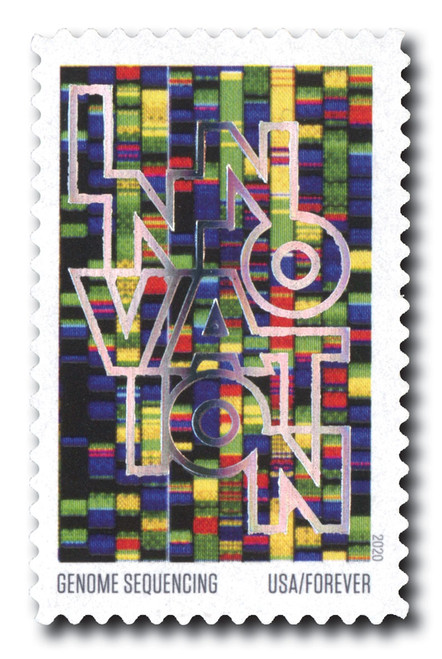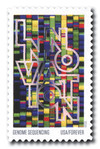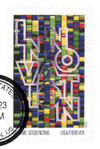
# 5516 - 2020 55c First-Class Forever Stamps - Innovation: Genome Sequencing
US #5516
2020 Genome Sequencing – Innovation
- One of five stamps celebrating American Innovation – this one commemorates advancements in the field of genome sequencing
Stamp Category: Commemorative
Set: Innovation
Value: 55¢ First Class Mail (Forever)
First Day of Issue: August 20, 2020
First Day City: Bellefonte, Pennsylvania
Quantity Issued: 14,000,000
Printed by: Banknote Corporation of America
Printing Method: Offset, Hot Foil Stamping
Format: Panes of 20
Tagging: Phosphor Tagged Paper, Block Tagged
Why the stamp was issued: To honor the achievements in the field of genome sequencing that have helped America grow into the nation it is today.
About the stamp design: Pictures block lettering of the word “Innovation” overlaying an existing photograph of a genome sequence. Designed by USPS art director Antonio Alcalá.
Special design details: Hot foil stamping was added to the word “Innovation.” This gives the letters a holographic shimmer and makes them stand out.
First Day City: The First Day of Issue postmark was from Bellefonte, Pennsylvania, but no First Day of Issue Ceremony was held due to the ongoing Covid-19 global pandemic. Instead, the stamps were released during the American Philatelic Society’s Virtual Stamp Show.
About the Innovation set: Includes five stamps honoring the importance of innovation in American history – past and present. Specifically celebrates breakthroughs in the fields of computing, biomedicine, genome sequencing, robotics, and solar technology. Each design pictures block lettering of the word “Innovation” overlayed on exiting photographs related to the theme of each stamp. Stamps were designed by USPS art director Antonio Alcalá
History the stamp represents: If you have ever heard the word “genome,” you may have wondered what exactly it means. This term is used in molecular biology and genetics and simply means the genetic makeup of an organism. Genomes are the tiny pieces of information that make up our DNA. These extremely small puzzle pieces are what make us humans, and not some other species.
Scientists have been working to sequence (or “map”) the genomes of different species since the 1970s. In fact, the first genome sequence was published by Walter Fiers of the University of Ghent, Belgium, in 1976. He successfully laid out the components of a virus called Bacteriophage MS2. The larger the organism, the more material there is to sift through to determine the exact genome sequence. The first animal to have its genome sequenced was a nematode worm (Caenorhabditis elegans) in 1998.
Early genome sequencing was done by hand. It wasn’t until computer technology caught up that larger organisms could have their genomes completely laid out. In fact, it took until 2003 to completely map the human genome.
The possible uses for genome sequencing are infinite. Hopefully, one day we will be able to use genome sequencing to diagnose and treat harmful genetic conditions before a person even has symptoms.
US #5516
2020 Genome Sequencing – Innovation
- One of five stamps celebrating American Innovation – this one commemorates advancements in the field of genome sequencing
Stamp Category: Commemorative
Set: Innovation
Value: 55¢ First Class Mail (Forever)
First Day of Issue: August 20, 2020
First Day City: Bellefonte, Pennsylvania
Quantity Issued: 14,000,000
Printed by: Banknote Corporation of America
Printing Method: Offset, Hot Foil Stamping
Format: Panes of 20
Tagging: Phosphor Tagged Paper, Block Tagged
Why the stamp was issued: To honor the achievements in the field of genome sequencing that have helped America grow into the nation it is today.
About the stamp design: Pictures block lettering of the word “Innovation” overlaying an existing photograph of a genome sequence. Designed by USPS art director Antonio Alcalá.
Special design details: Hot foil stamping was added to the word “Innovation.” This gives the letters a holographic shimmer and makes them stand out.
First Day City: The First Day of Issue postmark was from Bellefonte, Pennsylvania, but no First Day of Issue Ceremony was held due to the ongoing Covid-19 global pandemic. Instead, the stamps were released during the American Philatelic Society’s Virtual Stamp Show.
About the Innovation set: Includes five stamps honoring the importance of innovation in American history – past and present. Specifically celebrates breakthroughs in the fields of computing, biomedicine, genome sequencing, robotics, and solar technology. Each design pictures block lettering of the word “Innovation” overlayed on exiting photographs related to the theme of each stamp. Stamps were designed by USPS art director Antonio Alcalá
History the stamp represents: If you have ever heard the word “genome,” you may have wondered what exactly it means. This term is used in molecular biology and genetics and simply means the genetic makeup of an organism. Genomes are the tiny pieces of information that make up our DNA. These extremely small puzzle pieces are what make us humans, and not some other species.
Scientists have been working to sequence (or “map”) the genomes of different species since the 1970s. In fact, the first genome sequence was published by Walter Fiers of the University of Ghent, Belgium, in 1976. He successfully laid out the components of a virus called Bacteriophage MS2. The larger the organism, the more material there is to sift through to determine the exact genome sequence. The first animal to have its genome sequenced was a nematode worm (Caenorhabditis elegans) in 1998.
Early genome sequencing was done by hand. It wasn’t until computer technology caught up that larger organisms could have their genomes completely laid out. In fact, it took until 2003 to completely map the human genome.
The possible uses for genome sequencing are infinite. Hopefully, one day we will be able to use genome sequencing to diagnose and treat harmful genetic conditions before a person even has symptoms.









